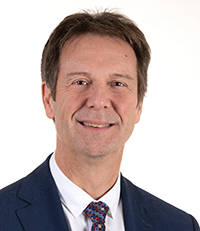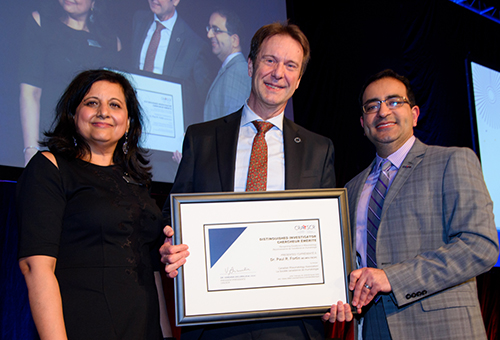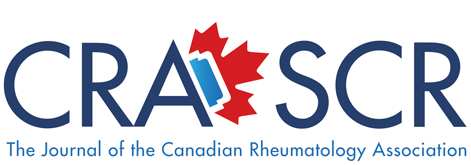Summer 2020 (Volume 30, Number 2)
The CRA's 2020 Distinguished Investigator:
Dr. Paul Fortin
Download PDF

What was your first thought when you learned that you would receive this award?
My first thought was “Am I that old already?” as it seemed impossible to me that I had accomplished enough in my career to merit this honour. Then, after regaining my composure and realizing that indeed the years had passed, I felt privileged to receive such a high recognition from my peers.
The importance of feeling that your work has been and remains valid (to use a qualification that clinical researchers love) and valued outside of your immediate circle is of great comfort. This is how I think of the CRA Distinguished Investigator Award: an endorsement that my work so far has enough meaning to be recognized by those closest to me and most apt to appreciate what I do, my fellow rheumatologists.
It is too often underestimated how insecure and uncertain the career of a clinical researcher can be. More often than not, we must learn to live with rejections of grants and papers, criticisms for unconventional ideas or propositions that may be outside the norm, challenges to convince others of the value of a research question, methodology or study design, or worst of all, indifference from funding agencies, research institutions or the public. I have spent countless hours – often at the expense of time I should have spent on personal and familial endeavours – securing a research agenda that would reflect my personal value, but most importantly my deep conviction that my research would eventually help one patient one day live a better life with arthritis. That conviction that what I do can make a difference one day in even a single person’s life has remained my most powerful motivation to go on when my chances for a future research career appeared bleak.
Surprisingly, others went along with my conviction and I have benefited from the support of family, patients, colleagues and the research community at large. I would have never been able to merit the CRA Distinguished Investigator Award without those who supported me and went along with such a risky business! I am so very grateful since this award indirectly recognizes their support as well.
Why did you become a rheumatologist? What or who influenced you along the way to do so?
It took time for the medical student and resident that I was to become intrigued, then interested and finally enthralled with rheumatology. The intrigue started during a rotation on an internal medicine ward when I trained as a medical student in Quebec City. I had not been exposed until then to patients with systemic autoimmune rheumatic diseases. During my 4-week rotation, I collected and wrote the histories and performed physical examinations on four incredibly wonderful people who lived with rheumatoid arthritis (RA), lupus, and systemic sclerosis. They were all young to middle-aged women who did not let their disease control their lives and were witnesses to the strength and beauty of the human spirit. A reversal of the roles occurred during their hospital stay, as these women became my teachers. One showed me how she had adapted to independently buttoning her blouse despite her deformed thumbs and hands from RA. Another joked about looking younger from her scleroderma skin involvement and shared her plans to return to work after her discharge from hospital. The youngest of the four had just been diagnosed with lupus and was understandably distraught and scared. She nevertheless believed wholeheartedly in getting better and intended to do so. The courage and resilience of these women impressed me profoundly and I realized then that I could see myself accompanying such people throughout their journey with arthritis.
The interest then came from learning more about the immune system and the fascinating phenomenon of autoimmunity. My senior resident during that same internal medicine rotation was my colleague of today, Dr. Charlotte Grondin. She was an excellent teacher and did not count the number of hours she taught us medical students. She patiently dissected the immune system for us and explained the different clinical manifestations of the systemic autoimmune rheumatic diseases. By the end of that rotation, I wanted to become a clinical . . . immunologist.
This interest in immunology and immunity guided me to McGill University where I trained in internal medicine.
McGill offered one of the few clinical programs in immunology to which I wanted to apply for my subspecialty training. I reconsidered my choice, however, after an elective rotation in rheumatology under the direction of Dr. John Esdaile. Dr. Esdaile was just returning from Yale after training in Epidemiology with Dr. Alvin Feinstein. I realized during this rotation that rheumatology offered me all that I deeply desired: the study of the immune system and of autoimmunity, a practice involving long-term care of incredibly courageous patients deserving of our care and a possibility to complement that with research that could one day change one patient’s life.
What do you believe are the qualities of a distinguished rheumatologist?
Distinguished or not, a rheumatologist’s most important quality is their humanity. Ours is a discipline that deals with daily sufferings that undermine the body and the soul. Scientific excellence, clinical experience and sound judgement are naturally essential qualities that all health-care professionals share. However, I am convinced that the quality that will serve the rheumatologist most will be humanity. How can you otherwise accompany patients that live with a debilitating disease that menaces not only their physical function but also their emotional and social lives? Giving up is not easy and until recently, arthritis caused patients to give up beyond what would be expected from natural aging. In my practice, heartfelt compassionate listening, prolonged silences, and acknowledgement that this disease "sucks" have served me as much as the wonderful new drugs I prescribe. Although difficult at times, I present myself as an adviser and a guide in the decisions my patients have to take. At times, I have also been their counsellor. I challenge myself to make sure that my patients are in agreement with their treatments and adopt them with the conviction that it is the right thing to do for themselves.
In my mind, humanity is the quality that allows me to connect with my patients and to strengthen the privileged bond of the rheumatologist-patient relationship.
You have been working to better understand the bio-psycho-social impact of chronic rheumatic diseases such as SLE, RA and other systemic autoimmune rheumatic diseases. How does your research influence the clinical care of patients? What has been the most gratifying aspect of this knowledge translation?
Interestingly, one of the most gratifying experiences in my research career has been what a patient reported to us after a very difficult episode in her life. This person lives with lupus and had been part of the Health Improvement and Prevention Program (HIPP). The HIPP study was a trial that studied a patient-focused intervention managed by a trained nurse practitioner that combined educational classes, health habit modifications including a supervised exercise program and an optional meditation-based stress reduction (MBSR) program. Following her experience with HIPP, the person who wrote to us had carried on with yoga, MBSR, and maintained an exercise program. The following year, she unfortunately developed pneumonia and respiratory failure that required intubation and mechanical ventilation. She then wrote to us that throughout that dreadful experience in intensive care, she had used the tools that she had acquired during the HIPP study. The meditation helped her get through the worst part of this experience and she is convinced that being physically fit, especially related to her respiratory musculature, was what allowed her to make it through and recover fully. This example will not be published in a peer-reviewed journal but it does motivate me to continue my work as it validates what I do in research.
Are there other areas of interest you would like to investigate in the future? What projects will you be undertaking in the near future?
So many! In fact, my wife worries that I will never get tired of asking research questions and starting new research projects. However, seriously, one interesting project I will likely never do is what attracted me back home to Quebec City. This is a study of the genetic-environmental interactions that may be associated with systemic autoimmune rheumatic diseases in French-Canadians. The idea would be to pool their genetic and familial data that are well documented and available for research (the founder effect here is unique with a few thousand common ancestors to millions of French Canadians) with environmental exposures. We would determine these environmental exposures using geospatial analyses. We could then propose genetic and environmental risk factors and interactions between genes and the environment associated with arthritis. This would require a population-based study, working closely with scientists in geography and with population scientists and anthropologists. Wouldn’t that be exciting? It would also require lots of money, and quite a convincing investigator to pull this off!
What is your proudest accomplishment?
My collaborations are my proudest accomplishments with a definite bias in favor of the Canadian Network for Improved Outcomes in SLE or CaNIOS. I came back from my clinical epidemiology training and my exposure to the Robert B. Brigham Multipurpose Arthritis Center in Boston with the conviction that numbers were key to getting answers to our questions. I have been privileged to receive funding over the years from the Arthritis Society, the Canadian Institutes of Health Research (CIHR) and CIORA to proceed with some of these questions. One of my early studies – a randomized controlled trial on the efficacy and safety of methotrexate in lupus – required that we recruit patients in several centers across Canada. John Esdaile guided me through the political maze that permitted the creation of CaNIOS. Its purpose was to perform one study, but it rapidly became obvious that this collaboration led to more interesting possibilities for research. Several other research projects by colleagues such as Ann Clarke, Patricia Dobkin, Debbie DaCosta, Christine Peschken, Joan Wither and others followed. CaNIOS remains active today, 25 years after its creation in 1995 and continues to offer a unique platform of research in lupus.
What advice would you give to someone looking to pursue a career as an academic rheumatologist?
Follow your instinct and your passion, but over and above all, make sure that you choose what you really like. What will make you wake up early in the morning and long to be already at work! No advanced planning or in-depth strategies here – complete abandonment! Never in a lifetime would I have dreamt of becoming an academic researcher in rheumatology (and one who would receive the CRA Distinguished Investigator Award at that). There are no guarantees that you will succeed but, if your instinct dictates that a career in academia is the right choice for you, my second and possibly most important advice is to seek advice. Ideally, you can find a mentor in your environment or at the CRA meetings. I have been personally privileged to have two mentors during my career. Both have been very generous with their time, support and advice. Early on, John Esdaile guided me through the decision of pursuing additional training in clinical research in Boston where I met my second mentor, Matthew Liang. They have both remained close advisers to this day.
If you had an extra hour in the day, how would you spend it?
I would love to improve my skills at photography – especially at nature photography with a specific interest in birds! I am a birder since my teens and there is nothing more healing and satisfying to me than walking nature trails. I plan to get the right equipment and to start working on these skills in the coming months so that I can prepare for retirement. After all, as I have said at the beginning, receiving the Distinguished Investigator Award is a great honour . . . but also a signal that time is passing by!

Dr.
Fortin receiving his award from CRA President Dr. Vandana Ahluwalia and
Dr. Raheem Kherani.
Paul R. Fortin, MD, MPH, FRCPC
Canada Research Chair on Systemic Autoimmune
Rheumatic Diseases
Rheumatologist, Division of Rheumatology
Researcher, Infectious and immune disease axis
CHU de Québec– Université Laval
Professor, Department of Medicine
Faculty of Medicine, Université Laval
Québec City, Québec
|
